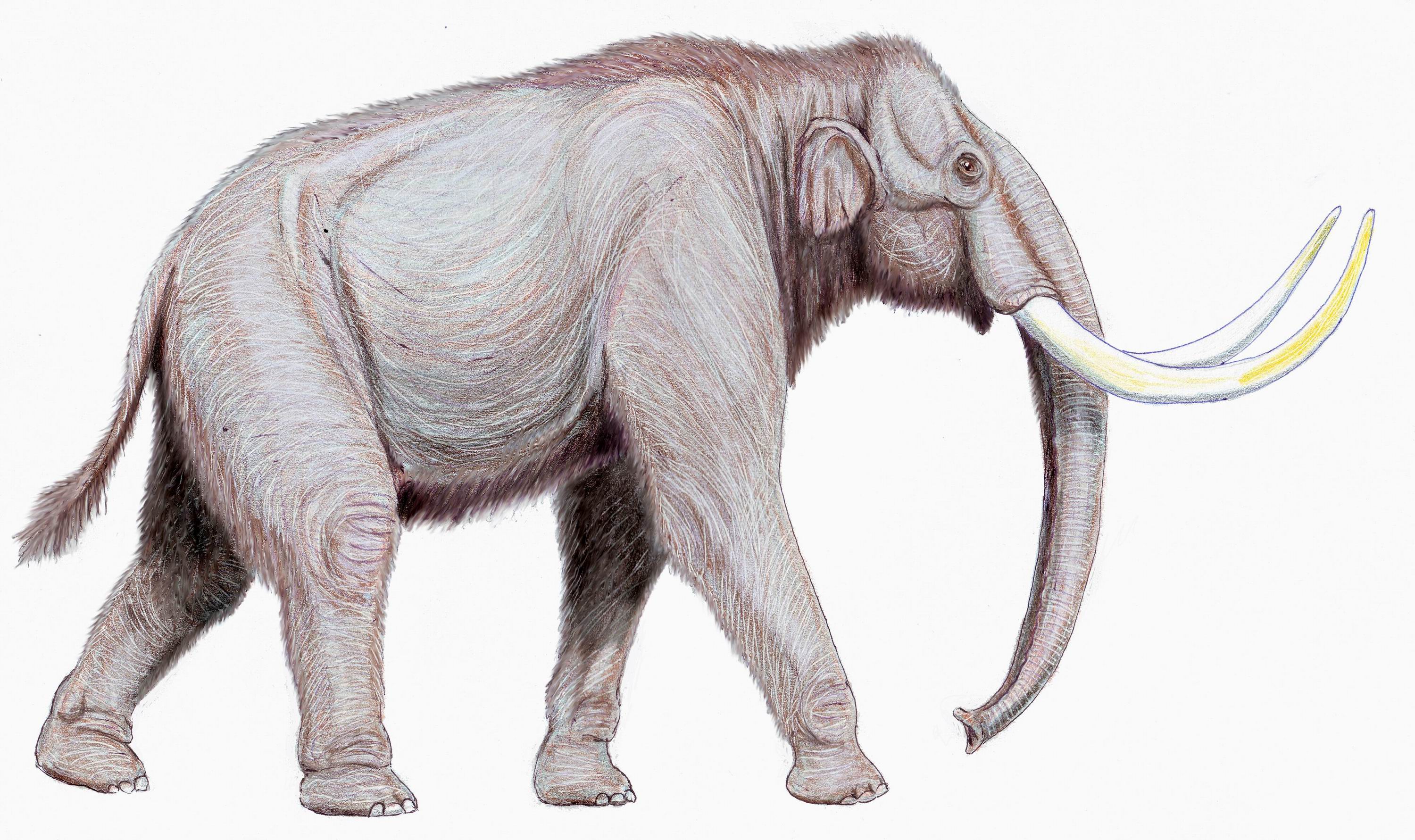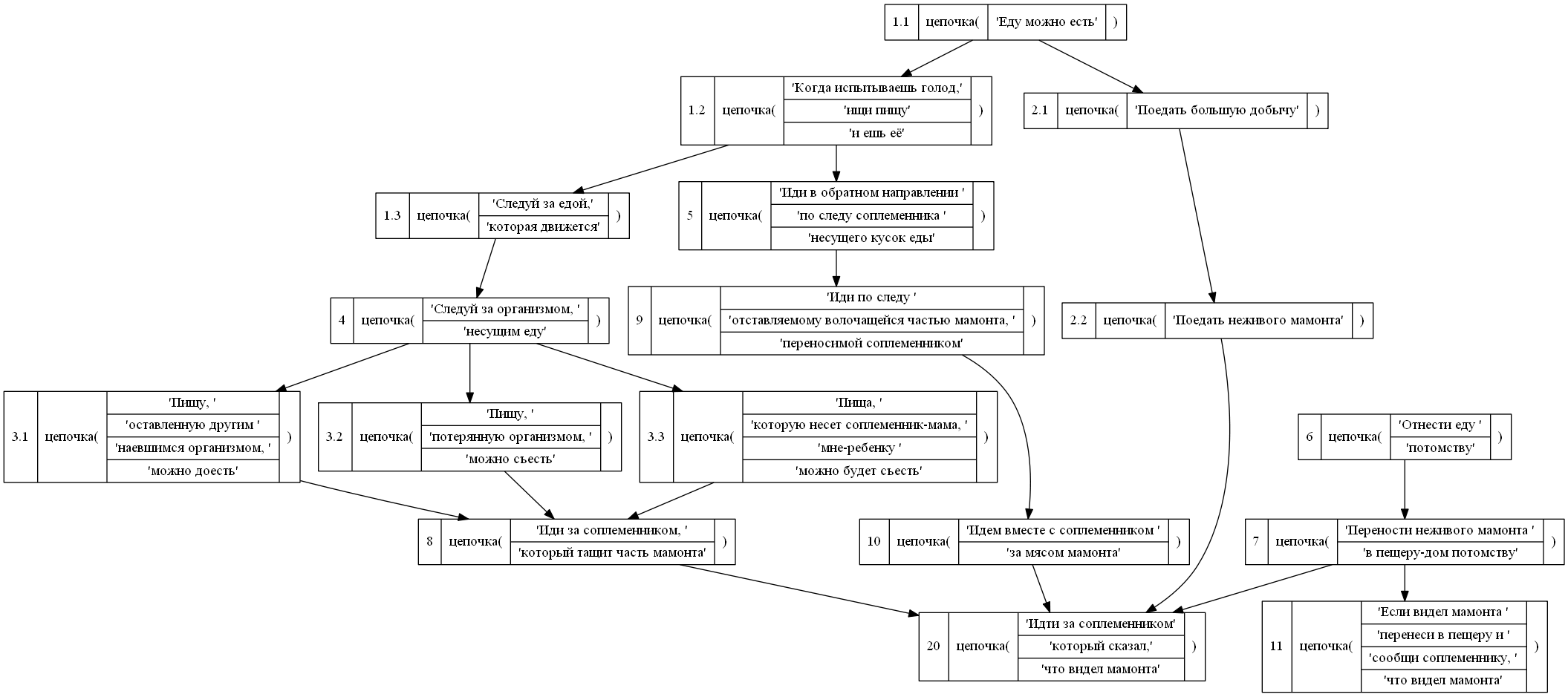How to form a noun in a language? Signal ("Saw the Mammoth")
Let's try to form a description of the process of the emergence of a new sound unit in natural language.
For this we consider a separate living tribe. And build a chain of situations that need to be experienced together by several individuals of this tribe, leading to the formation of a new sound in the language.
The sound that we try to form will be identical to the phrase: "I saw a mammoth."

Introduction
To solve the problem, consider the following space:
- a cave tribe with rudiments of sounding events,
- adult individuals of the tribe provide food for themselves and children,
- children do not leave the cave
- to search for food, adults leave the cave and examine the area around it,
- lifeless mammoths are sometimes found near the cave,
- the lifeless mammoth is a large supply of food for the whole tribe.
In this situation, the following behavior of an individual when detecting an inanimate mammoth far from a cave is advisable:
- to eat
- tear off a piece of meat and take it to the babies in the cave,
- if necessary, return to the mammoth and repeat the first two steps.
For other individuals of the tribe, it is advisable to find out where the mammoth is. To do this, they can go along with the found individual to the place of detection, but first they need to know that following this individual will be useful.
That is, it will be useful if the individual who found the mammoth says to the other individuals the phrase: "I saw a mammoth." If you write formally, it will form a signal ("I saw a mammoth").
At the same time, the individual that received the signal (“Seen the Mammoth”) must know about this signal and perform complex behavior. That is, should proceed further for the found individual to the place of discovery. Formally, we write: action ("Go for the tribesman to the mammoth").
This useful behavior algorithm, which, when a signal is detected , performs an ordered set of actions , is called a chain and is written in the form:
(" , , ") { (" ") --> (" ") } In order to continue, we need another term denoting an algorithm that is accessible to an individual, which allows it to unambiguously recognize a specific situation. For example, a method would be needed that allows an individual to determine that a large object, covered with fur and lying motionless, is an inanimate mammoth. This algorithm is formally denoted as: symbol ("Inanimate mammoth").
The term specialization for the following objects refers to a process similar to the evolutionary specialization of cells in a living organism.
It seems that all the necessary notation is given. If the article further meets incomprehensible, I will gladly explain them in the comments. Many of the chains used below are explained by food-based search behavior based on the symbol ("Hunger").
Way
The method consists in finding a sequence of situations jointly experienced by the tribesmen that formed the required signal ("saw a mammoth"). Imagine the chains , available individuals, nodes of a directed graph. Let's connect these nodes, showing the dependence of the appearance of each chain on the already existing ones, at the time of this appearance. Then the sequence of situations that you want to find determines the path in this column. The path will show the chaining order required for the signal to appear.
Construct a chain formation graph. The search will be conducted on a graph from two sides:
- in the direction from trivial chains (that is, from the simplest ones that are originally present),
- away from the target chain .
Direction from trivial chains
We now give the chains ordered in order of formation, starting with the trivial ones. Trivial chains will be a group of chains explained by food search behavior :
1.1 (" ") { ("") --> (" ") // !!! } 1.2 (" , ") { ("") --> (" ") [ (" ") || (" ") ] } In the chain <1.2>, a new designation is used, indicating that the action is performed with the independent use indicated in square brackets: chains (“I need food to eat”) and another action (“Move in space”).
1.3 (" , ") { (" ") --> (" ") } The specialization of the chain <1.1> is the following chain :
2.1 (" ") { (" ") --> (" ") (" ") } As a specialization of the symbol ("Large object from meat") appears the symbol ("Inanimate mammoth"). A new specialization of the <2.1> chain (“Eat more prey”) is added in the form of a chain :
2.2 (" ") { (" ") --> (" ") (" ") } Next, I will cite the chains , entirely described by the explanatory phrase, without revealing their internal structure.
3.1 (", , ") 3.2 (", , ") 3.3 (", -, - .") The specialization of the chain <1.3> ("Follow the food that moves") is the following chain :
4 (" , ") { (" ") --> (" ") } The following is a non-trivial chain , the description of the formation of which should be disassembled in a separate article:
5 (" ") { (" ") --> (" ") } The following chains form the parent behavior .
In this case, we emphasize that the "Cave" is the place where the offspring are raised (the children of the tribe).
6 (" ") { (" ") --> (" ") (" ") } Next we give the specialization of the chain ("Take food to offspring"):
7 (" - ") { (" -") --> (" ") [ (" ") { (" ") --> (" ") (" ") } || (" ") { (" ") --> (" ") } ] (" ") } Not all of these chains may be needed in finding the path of the graph, but the more there will be and the more interconnections between them the more useful.
We form a graph in the direction from the chains using the signal
Signal use chains ("Saw the mammoth"):
20 (" , , ") { (" ", (" ")) --> (" ") } 8 (" , ") { (" ") --> (" ") } 9 (" , , ") { (" , ") --> (" ") } The chain <9> (“Walk along the trail left by the dragging part of the mammoth carried by the tribesman”) is the specialization of the chain <5> (“Go backwards along the trace of the tribesman carrying a piece of food”).

Drawn in GraphViz
Search for situations combining two "adjoining" graph
It is necessary to find simple situations that ensure the appearance of a chain ("Go for a tribesman who says he saw a mammoth")
This will require the following clarifications to space objects:
- Tribe - many organisms with communication
- Two or more adult bodies
- One or more young organisms in a cave house
Possible sequence of events:
Adult organism (<1>):
- found a lifeless mammoth in location A far from the cave-house,
- tears off a piece of meat, eats itself,
- uses a chain ("Carrying an inanimate mammoth into a cave house"):
- tears off a big piece of meat
- dragging this piece to the cave, leaving a trail
- feeds the cub
- re-goes back to seat A , checks to see if there is any meat left.
Adult organism (<2>):
- being in this moment in the cave, he sees how the organism (<1>) drags the meat,
- then uses a chain ("Go backwards along the track of the tribesman carrying food").
At the time of the meeting in the cave, the body (<2>) has already formed the chains necessary for beneficial action in the current situation. The only addition in this situation becomes a new symbol ("the tribesman brought the mammoth meat from afar") in the body's detection subsystem (<2>). And this symbol is fixed by the usefulness of the food found.
And further with this symbol other useful chains can be formed.
In the situation of joint movement of tribesmen to place A on the left trail, the chain <9> is first used (“Follow the trail of the dragging part of the mammoth carried by the tribesman”)
In parallel with it, a second chain is being formed, reinforced by food:
10 (" ") { (" ") --> (" ") (" ") } In the future, in the absence of a trace (for example, a fruit tree instead of a mammoth), the chain (“Follow the mammoth meat”) can no longer work.
But if organisms have a chain ("Return to an important place along a memorized route"), then it is used by the organism (<1>), who has found a mammoth to return to location A.
And the organism (<2>), which received the signal ("saw the mammoth"), begins to use the chain ("We go along with the tribesman for the mammoth meat").
The most interesting thing remains: the separation of the signal ("seen a mammoth") from a piece of meat. And it is quite simple.
If at the time of the meeting in the cave the organism (<1>), which has found the mammoth, generates a unique signal , which is specialized from the signal that marks an important event in the learning process. Then this signal becomes for the body (<2>) a signal ("seen a mammoth"). This signal is fixed, and in the future on its basis new parallel chains are formed :
11 (" , ") { (" ") --> [ (" , ") { (" ") --> (" ", (" ")) } (" - ") ] } (" , , ") { (" ", (" ")) --> (" ") (" ") } Conclusion
As a result of the work done, we received step-by-step details of the development of the communication system in individuals of one tribe. This development occurs in individuals of the tribe in shared situations. The considered development provided the formation of a target chain and a signal based on the already existing chains .
The developed model and method of analyzing the process of forming chains and signals in a population of organisms makes it possible to study other mechanisms for the development of a language and try to analyze the work of consciousness.
Returning to the title, I agree that there is an inconsistency between the word "noun" and the phrase "I saw a mammoth." Perhaps the title should be changed. The following meaning was put into the current version of the title: the word "noun" should emphasize the fact that in communication the body talks about an existing , but not visible, object in its current space.
If this doesn’t bother you, and you’ll find errors using terms, wording errors, and writing style, please let me know about them at Issues (bitbucket.org) . I pledge to correct them by the presence of time and energy.
To work on this article, unfortunately, I can only allocate night time, so I apologize in advance for delaying corrections and replies to comments.
Sincerely.
Links
Reviews
In the process of working on the topic discussed in the article, there are very few third-party reviews: critical, evaluating - with experience, thoughts, and particular examples on the subject. It is very hard to work alone with oneself and, on the contrary, to use communication effectively in this.
Now (in anticipation of your comments) I am in a state of "weightlessness" and do not know at all which way to push off. Thank you in advance.
Sincerely.
')
Source: https://habr.com/ru/post/446834/
All Articles